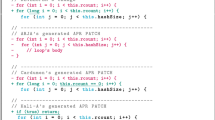Abstract
In software development, refactoring is a process that improves the system internal structure without altering its external behavior. Applying design patterns, which are common reusable solutions of several kinds of problems is widely adopted. This technique, however, raises a challenging issue that after applying design patterns the software system may not preserve some certain behavioral properties. This paper proposes a new approach to checking consistency between original software system and its evolution at both design and implementation phases. First, we formalize elements of software designs and programs. Methods, based on these formalizations, are proposed for verifying the design and implementation of the system. Finally, the paper presents a case study of Adaptive Road Traffic Control system to illustrate the proposed approach in detail.







Similar content being viewed by others
References
Object management group. ocl 2.4 specification. (2014)
Advice leaflet 1: The “scoot” urban traffic control system: http://www.scoot-utc.com, (2016)
Alexander C, Ishikawa S, Silverstein M (1977) Pattern languages. Center for Environmental Structure 2:1977
Beckert B, Keller U, Schmitt PH (2002) Translating the object constraint language into first-order predicate logic. In: Proceedings, VERIFY, workshop at federated logic conferences (FLoC), pp 113–123
Bottoni P, Parisi-Presicce F, Taentzer G (2003) Coordinated distributed diagram transformation for software evolution. Electron Notes Theor Comput Sci 72(4):59–70
Bottoni P, Parisi-Presicce F, Taentzer G (2003) Coordinated distributed diagram transformation for software evolution1 1partially supported by the ec under research and training network segravis. Electron Notes Theor Comput Sci 72(4):59–70
Burdy L, Cheon Y, Cok DR, Ernst MD, Kiniry JR, Leavens GT, Rustan K, Leino M, Poll E (2005) An overview of jml tools and applications. Int J Softw Tools Technol Transfer 7(3):212–232
Cabot J, Gogolla M (2012) Object constraint language (ocl): a definitive guide. In: Proceedings of the 12th international conference on formal methods for the design of computer, communication, and software systems: formal methods for model-driven engineering, SFM’12. Springer, Berlin, Heidelberg, pp 58–90
Cok DR (2011) Openjml: Jml for java 7 by extending openjdk. In: NASA formal methods symposium. Springer, pp 472–479
De Moura L, Bjørner N (2008) Z3: an efficient smt solver. In: Proceedings of the theory and practice of software, 14th international conference on tools and algorithms for the construction and analysis of systems, TACAS’08/ETAPS’08. Springer, Berlin, Heidelberg, pp 337–340
Dong J, Sheng Y, Zhang K (2006) A model transformation approach for design pattern evolutions. In: 13th annual IEEE international symposium and workshop on engineering of computer based systems, 2006. ECBS 2006, pp 10–92
Van Eetvelde N, Janssens D (2003) A hierarchical program representation for refactoring, vol 82. UNIGRA’03, Uniform Approaches to Graphical Process Specification Techniques (Satellite Event for {ETAPS} 2003)
Gamma E, Helm R, Johnson R, Vlissides J (1995) Design patterns: elements of reusable object-oriented software. Addison-Wesley Longman Publishing Co., Inc., Boston
He J (2005) Consistency checking of uml requirements. In: Proceedings of the 10th IEEE international conference on engineering of complex computer systems, ICECCS ’05. IEEE Computer Society, Washington, DC, USA, pp 411–420
Leavens GT, Baker AL, Ruby C (2006) Preliminary design of jml: a behavioral interface specification language for java. ACM SIGSOFT Software Engineering Notes 31(3):1–38
Leavens GT, Poll E, Clifton C, Cheon Y, Ruby C, Cok D, Müller P, Kiniry J, Chalin P, Zimmerman DM, Dietl W, et al. (2008) Available from http://www.jmlspecs.org/
Marché C, Paulin-Mohring C, Urbain X (2004) The krakatoa tool for certificationof java/javacard programs annotated in jml. J Logic Algebraic Program 58(1):89–106
Matsumoto T, Sakunkonchak T, Saito H, Fujita M (2003) Verification of behavioral consistency in c by using symbolic simulation and program slicer. In: Model checking for dependable software-intensive systems workshop, pp 80–84
Mens T, Tourwe T (2004) A survey of software refactoring. IEEE Trans Softw Eng 30(2):126–139
Mens T, Demeyer S, Janssens D (2002) ForMalising behaviour preserving program transformations. In: Corradini A, Ehrig H, Kreowski H -J, Rozenberg G (eds) Graph transformation, volume 2505 of lecture notes in computer science. Springer, Berlin Heidelberg, pp 286–301
Opdyke WF (1992) Refactoring: a program restructuring aid in designing object-oriented application frameworks. PhD thesis, University of Illinois at Urbana-Champaign
Rasch H, Wehrheim H (2003) Checking consistency in uml diagrams: classes and state machines. In: Najm E, Nestmann U, Stevens P (eds) Formal methods for open object-based distributed systems, volume 2884 of lecture notes in computer science. Springer, Berlin Heidelberg, pp 229–243
Van Der Straeten R, Mens T, Simmonds J, Jonckers V (2003) Using description logic to maintain consistency between uml models. In: Stevens P, Whittle J, Booch G (eds) ÇUMLÈ 2003 - the unified modeling language. Modeling languages and applications, volume 2863 of lecture notes in computer science. Springer, Berlin Heidelberg, pp 326–340
Ward MP, Bennett KH (1995) Formal methods to aid the evolution of software. Int J Softw Eng Knowl Eng 5:25–47
Zhao C, Kong J, Zhang K (2007) Design pattern evolution and verification using graph transformation. In: 40th annual hawaii international conference on system sciences, 2007. HICSS 2007, pp 290a–290a
Acknowledgments
This work is partly supported by the project no. 102.03–2014.40 granted by Vietnam National Foundation for Science and Technology Development (Nafosted).
Author information
Authors and Affiliations
Corresponding author
Rights and permissions
About this article
Cite this article
Le, H.A., Dao, TH. & Truong, NT. A Formal Approach to Checking Consistency in Software Refactoring. Mobile Netw Appl 22, 356–366 (2017). https://doi.org/10.1007/s11036-017-0807-z
Published:
Issue Date:
DOI: https://doi.org/10.1007/s11036-017-0807-z




